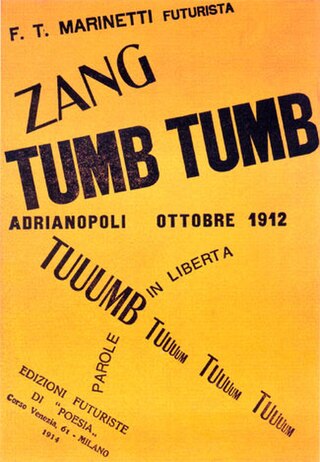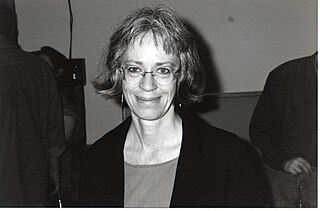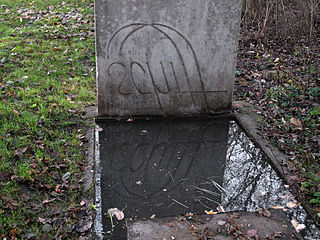Sound poetry is an artistic form bridging literary and musical composition, in which the phonetic aspects of human speech are foregrounded instead of more conventional semantic and syntactic values; "verse without words". By definition, sound poetry is intended primarily for performance.
Visual poetry is a style of poetry that incorporates graphic and visual design elements to convey its meaning. This style combines visual art and written expression to create new ways of presenting and interpreting poetry.

Neo-Dada was a movement with audio, visual and literary manifestations that had similarities in method or intent with earlier Dada artwork. It sought to close the gap between art and daily life, and was a combination of playfulness, iconoclasm, and appropriation. In the United States the term was popularized by Barbara Rose in the 1960s and refers primarily, although not exclusively, to work created in that and the preceding decade. There was also an international dimension to the movement, particularly in Japan and in Europe, serving as the foundation of Fluxus, Pop Art and Nouveau réalisme.

Zang Tumb Tumb is a sound poem and concrete poem written by Filippo Tommaso Marinetti, an Italian futurist. It appeared in excerpts in journals between 1912 and 1914, when it was published as an artist's book in Milan. It is an account of the Battle of Adrianople, which he witnessed as a reporter for L'Intransigeant. The poem uses Parole in libertà and other poetic impressions of the events of the battle, including the sounds of gunfire and explosions. The work is now seen as a seminal work of modernist art, and an enormous influence on the emerging culture of European avant-garde print.
"[The] masterpiece of Words-in-freedom and of Marinetti’s literary career was the novel Zang Tumb Tuuum... the story of the siege by the Bulgarians of Turkish Adrianople in the Balkan War, which Marinetti had witnessed as a war reporter. The dynamic rhythms and onomatopoetic possibilities that the new form offered were made even more effective through the revolutionary use of different typefaces, forms and graphic arrangements and sizes that became a distinctive part of Futurism. In Zang Tumb Tuuum; they are used to express an extraordinary range of different moods and speeds, quite apart from the noise and chaos of battle.... Audiences in London, Berlin and Rome alike were bowled over by the tongue-twisting vitality with which Marinetti declaimed Zang Tumb Tuuum. As an extended sound poem it stands as one of the monuments of experimental literature, its telegraphic barrage of nouns, colours, exclamations and directions pouring out in the screeching of trains, the rat-a-tat-tat of gunfire, and the clatter of telegraphic messages." — Caroline Tisdall and Angelo Bozzola
Jeremy Adler is a British scholar and poet, and emeritus professor and senior research fellow at King's College London. As a poet he is known especially for his concrete poetry and artist's books. As an academic he is known for his work on German literature specialising in the Age of Goethe, Romanticism, Expressionism and Modernism with contributions on figures such as Goethe, Hölderlin, and Kafka.
Craig Saper is Professor of Language, Literacy, & Culture at the University of Maryland Baltimore County (UMBC).
An altar poem is a pattern poem in which the lines are arranged to look like the form of an altar. The text and shape relate to each other, the latter usually giving added meaning to the poem itself. The tradition of shaped poetry goes back to Greek poets writing in Alexandria before the Common Era but most examples date from later and were written by European Christian poets during the Baroque period.
Andrew Lewison Hoyem is a typographer, letterpress printer, publisher, poet, and preservationist. He is the founder and was the director of Arion Press in San Francisco until his retirement in October 2018. Arion Press "is considered the nation's leading publisher of fine-press books," according to the Minneapolis Star Tribune. Arion Press "carries on a grand legacy of San Francisco printers and bookmakers," according to Michael Kimmelman of The New York Times. Hoyem’s work in preserving the nation’s last typefoundry has been recognized by the National Trust for Historic Preservation.

Öyvind Axel Christian Fahlström was a Swedish multimedia artist.
Dom Pierre-Sylvester HouédardWED-ar, also known by the initials 'dsh', was a British Benedictine priest, theologian and noted concrete poet.
Tango With Cows: Ferro-Concrete Poems is an artists' book by the Russian Futurist poet Vasily Kamensky, with additional illustrations by the brothers David and Vladimir Burliuk. Printed in Moscow in 1914 in an edition of 300, the work has become famous primarily for being made entirely of commercially produced wallpaper, with a series of concrete poems - visual poems that employ unusual typographic layouts for expressive effect - printed onto the recto of each page.

Richard Kelly Tipping is an Australian poet and artist best known for his visual poetry, word art, and large-scale public artworks. Examples of his work are held in major collections in Australia and abroad.

Signalism represents an international neo-avant-garde literary and art movement. It gathered wider support base both in former Yugoslavia and the world in the late 1960s and the beginning of the 1970s.
Bianca Lynne Spriggs is an American poet and multidisciplinary artist born in Milwaukee, WI. While widely considered a born-and-bred Kentuckian, she actually moved around a lot due to the nature of her parents' work. For several years of her childhood, she would bounce around from Florida, Indiana, and Milwaukee. She moved to Kentucky when she was eleven years old and lived there the longest. She currently resides in Athens, OH where she is an Assistant Professor of English at Ohio University. As a second generation Affrilachian Poet, she is the author of Kaffir Lily, How Swallowtails Become Dragons, The Galaxy is a Dance Floor, and Call Her By Her Name. She is the editor of The Swallowtale Project: Creative Writing for Incarcerated Women (2012), and co-editor of the anthologies, Circe's Lament: An Anthology of Wild Women, Undead: A Poetry Anthology of Ghouls, Ghosts, and More, and Black Bone: 25 Years of the Affrilachian Poets(University of Kentucky Press, 2018).
Lenora de Barros is a Brazilian artist and poet. She studied linguistics at the University of São Paulo before establishing her artistic practice during the 1970s, and has remained committed to the exploration of language through a variety of media, including video, performance, photography and installation.
Paula Claire is a British Poet-Artist, whose work spans the areas of sound, visual, concrete and performance poetry. She was associated with the British Poetry Revival Movement in the 1970s and a member of Konkrete Canticle, a poetry collective founded by Bob Cobbing, which performed works for multiple voices and instruments. She has performed and exhibited her poetry internationally since 1969, creating site-specific performance pieces and using the voice contributions of her audience. She is founder and curator of the Paula Claire Archive: fromWORDtoART - International Poet-Artists, a collected body of work by fellow poet-artists.

Tatev Chakhian is a Poland-based Armenian poet, artist, editor and translator.

Stanisław Dróżdż was a Polish artist. He is a representative of concrete poetry, and a pioneer of this movement in Polish art. He graduated from the University of Wrocław with a diploma from the Faculty of Polish philology. While the writers’ union did not accept him with the degree in Polish, Dróżdż became a member of the artists association

Judith Copithorne is a Canadian concrete and visual poet.
Alain Arias-Misson is an American-Belgian poet, writer, critic and visual artist whose multimedia literary works range from typewriter poetry, sound poetry, concrete and visual poetry to stories and experimental novels. He is particularly known for his three-dimensional poem objects and the so-called public poems - happenings with performers who carry life-sized letters through the streets of various cities.










